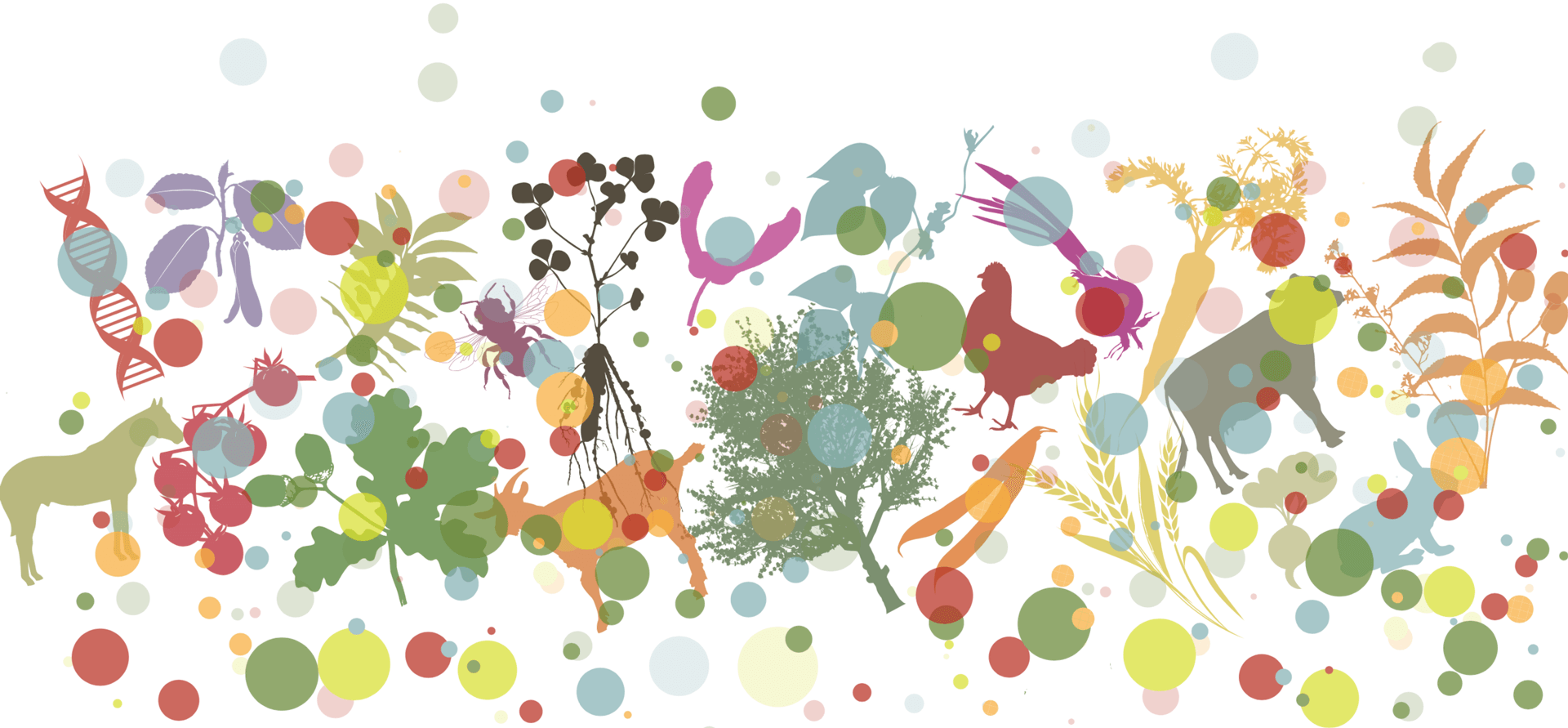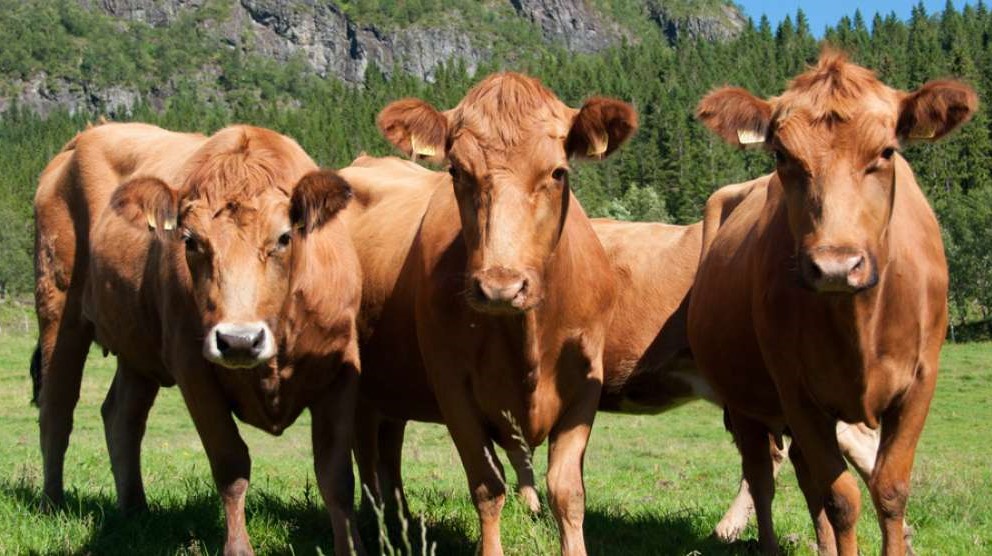Carcass characteristics of Nordic native cattle breeds
Main Article Content
Abstract
All Finnish and most of the Norwegian and Swedish native breeds had lower net gain and carcass weight than the dairy breeds in the same category and country, but with similar carcass conformation and fatness scores. The two Danish native breeds had higher net gain, carcass weight and conformation class than the reference dairy breed, but lower than the reference beef breeds. The net gain and carcass traits of the Icelandic native breed were similar to the smallest-sized native breeds from the other countries. The carcass traits of the native breeds indicate that they have comparative advantages in an extensive production system based on forage and marginal grasslands. They may also succeed better in the value-added markets than in mainstream beef production.
Article Details

This work is licensed under a Creative Commons Attribution 4.0 International License.
Authors retain copyright of the articles published in Genetic Resources and grant the journal right of first publication with open access. All articles published in Genetic Resource are licensed under Creative Commons Attribution 4.0 International License (CC BY 4.0) that allows others to download, share and adapt the work for commercial and non-commercial purposes as long as proper attribution to the original article is given. Genetic Resources permits and encourages authors to post items submitted to the journal (including the publisher's final layout) on personal websites or institutional repositories after acceptance and/or publication, while providing bibliographic details that credit their publication in Genetic Resources.
Aass, L and C G Fristedt (2003). En foreløpig karakterisering av kjøttkvalitet i STN (Sidet trøndefe og nordlandsfe). URL: http://www.umb.no/statisk/husdyrforsoksmoter/2005/073.pdf.
Agrogen Is (2021). Breeding goals for íslenska kúakynið. URL: https://agrogen.is/wp-content/uploads/2021/08/Raektunarmarkmid.pdf.
Albertí, P et al. (2008). “Live weight, body size and carcass characteristics of young bulls of fifteen European breeds”. Livestock Science 114(1), pp. 19–30. DOI: https://doi.org/10.1016/j.livsci.2007.04.010. DOI: https://doi.org/10.1016/j.livsci.2007.04.010
Andersen, B B et al. (1977). “Growth, feed utilization, carcass quality and meat quality in Danish dual-purpose cattle”. In: Beretn. 453 Statens Husdyrbrugsforsøg, Landhusholdningsselskabets forlag. Vol. 26, p. 86.
Andersen, H R (1975). “The influence of slaughter weight and level of feeding on growth rate, feed conversion and carcass composition of bulls”. Livestock Production Science 2(4), pp. 341–355. DOI: https://doi.org/10.1016/0301-6226(75)90118-9. DOI: https://doi.org/10.1016/0301-6226(75)90118-9
Ásbjarnardóttir, M G et al. (2010). “Analysis of genetic diversity and population structure within the Icelandic cattle breed using molecular markers”. Acta Agriculturae Scandinavica, Section A - Animal Science 60(4), pp. 203–210. DOI: https://doi.org/10.1080/09064702.2010.538714. DOI: https://doi.org/10.1080/09064702.2010.538714
Beilharz, R G, B G Luxford, and J L Wilkinson (1993). “Quantitative genetics and evolution: Is our understanding of genetics sufficient to explain evolution?” J. Anim. Breed. Genetics 110(1:6), pp. 161–170. DOI: https://doi.org/10.1111/j.1439-0388.1993.tb00728.x. DOI: https://doi.org/10.1111/j.1439-0388.1993.tb00728.x
Belin, Y (2017). “Rödkullan i nutid mot framtid”. Hushållningssällskapet 60.
Bläuer, A (2015). Voita, villaa ja vetoeläimiä: karjan ja karjanhoidon varhainen historia Suomessa. Vol. 218. Finland.
Bonny, S P F et al. (2016). “European conformation and fat scores have no relationship with eating quality”. Animal 10(6), pp. 996–1006. DOI: https://doi.org/10.1017/S1751731115002839. DOI: https://doi.org/10.1017/S1751731115002839
Christensen, M et al. (2011). “Relationship between collagen characteristics, lipid content and raw and cooked texture of meat from young bulls of fifteen European breeds”. Meat Science 87(1), pp. 61–65. DOI: https://doi.org/10.1016/j.meatsci.2010.09.003. DOI: https://doi.org/10.1016/j.meatsci.2010.09.003
Claesson, M and J Ekberg (2015). Rutiner för kastrering av köttrastjurar på några sydsvenska gårdar (Procedures for castration of beef bulls in some southern Swedish farms). Alnarp. URL: https://stud.epsilon.slu.se/8567/7/claesson_et_al_151020.pdf.
Commission of the European Union (2017). Commission Delegated Regulation (EU) 2017/1182 of 20 April 2017 supplementing Regulation (EU) No 1308/2013 of the European Parliament and of the Council as regards the Union scales for the classification of beef, pig and sheep carcasses and as regards the reporting of market prices of certain categories of carcasses and live animals. URL: http://data.europa.eu/eli/reg_del/2017/1182/oj.
Council of the European Union (2013). Regulation (EU) No 1308/2013 of the European Parliament and of the Council of 17 December 2013 establishing a common organisation of the markets in agricultural products and repealing Council Regulations (EEC) No 922/72, (EEC) No 234/79, (EC) No 1037/2001 and (EC) No 1234/2007. URL: http://data.europa.eu/eli/reg/2013/1308/2021-12-07.
Dahlström, A (2006). Betesmarker, djurantal och betestryck 1620-1850. Naturvårdsaspekter på historisk beteshävd i Syd- och Mellansverige. (Pastures, livestock and stocking rate 1620-1850. Nature conservation aspects on historical grazing in Southern and Central Sweden). Doctoral thesis 95. Uppsala, Sweden.
Danish Crown (2022). Aktuel og historisk kreaturnotering. URL: https://ejer.danishcrown.com/kreatur/notering/aktuel-kreaturnotering/ (visited on 08/12/2022).
De Vries, M, C E Van Middelaar, and I J M De Boer (2015). “Comparing environmental impacts of beef production systems: A review of life cycle assessments”. Livestock Science 178, pp. 279–288. DOI: https://doi.org/10.1016/j.livsci.2015.06.020. DOI: https://doi.org/10.1016/j.livsci.2015.06.020
Emanuelsson, U (2009). The rural landscapes of Europe - How man has shaped European nature. Vol. 384. Stockholm, Sweden: Formas Research Council.
Exceptionell Råvara (2022). URL: https://exceptionellravara.se/resultat-fran-smakmoten/ (visited on 07/23/2022).
FAO (2007). Global plan of action for animal genetic resources and the Interlaken declaration. Commission on Genetic Resources for Food and Agriculture. Ed. by and others. Rome: FAO. URL: http://www.fao.org/3/a-a1404e.pdf.
Ferðamálastofa-Icelandic Tourist Board (2016). International Visitors in Iceland: Summer 2016. URL: https://www.ferdamalastofa.is/static/files/ferdamalastofa/Frettamyndir/2017/januar/sunarkonnun/sumar-2016-islensk.pdf
Reykjavík, Iceland: Icelandic Tourist Board, p. 10. URL: https://www.ferdamalastofa.is/static/files/ferdamalastofa/Frettamyndir/2017/januar/sunarkonnun/sumar-2016-islensk.pdf.
Föreningen Äldre Boskap (2022). Vad är en fjällnära? URL: https://boskap.nu/bevarandet. Gautason, E et al. (2020). “Relationship of Icelandic cattle with Northern and Western European cattle breeds, admixture and population structure”. Acta Agriculturae Scandinavica, Section A - Animal Science 69, pp. 25–38. DOI: https://doi.org/10.1080/09064702.2019.1699951. DOI: https://doi.org/10.1080/09064702.2019.1699951
Guzek, D et al. (2016). “Effect of carcass fat and conformation class on consumer perception of various grilled beef muscles”. Journal of Food Science and Technology-Mysore 53(10), pp. 3778–3786. DOI: https://doi.org/10.1007/s13197-016-2364-z. DOI: https://doi.org/10.1007/s13197-016-2364-z
Hallander, H (1989). Svenska lantraser. Bokförlaget Blå Ankan AB, Veberöd, p. 600. Hessle, A (2009). “Kalvningar och skötsel av allmogekor 1995-2008”. Allmogekon 16(3), pp. 6–7.
Hessle, A, F Dahlström, et al. (2014). “Effects of breed on foraging sites and diets in dairy cows on mountain pasture”. International Journal of Biodiversity Science 10, pp. 334–342. DOI: https://doi.org/10.1080/21513732.2014.968805. DOI: https://doi.org/10.1080/21513732.2014.968805
Hessle, A and K - I Kumm (2011). “Use of beef steers for profitable management of biologically valuable semi-natural pastures in Sweden”. Journal for Nature Conservation 19, pp. 131–136. DOI: https://doi.org/10.1016/j.jnc.2010.10.002. DOI: https://doi.org/10.1016/j.jnc.2010.10.002
Hessle, A, M Rutter, and K Wallin (2008). “Effects of breed, season and pasture moisture gradient on foraging behaviour in cattle on semi-natural grasslands”. Applied Animal Behaviour Science 111(1-2), pp. 108–119. DOI: https://doi.org/10.1016/j.applanim.2007.05.017. DOI: https://doi.org/10.1016/j.applanim.2007.05.017
Hilmarsson, O T et al. (2000). “Samanburður á alíslenskum, Angus x íslenskum og Limósín x íslenskum nautgripum. II - Slátur- og kjötgæði. (Comparing Icelandic, Angus x Icelandic and Limosine x Icelandic bulls.II- slaughter and meat quality. (In Icelandic)”. Ráðunautafundur 2000. Annual Agricultural Conference 2000, pp. 196–205. URL: http://kjotbokin.is/wp-content/uploads/2012/06/Samanburður-á-alíslenskum-Angus-x-íslenskum-og-Limósín-x-íslenskum-natugripum-II.pdf
HkScan Agri (2021). Notering. URL: http://www.hkscanagri.se/notering/ (visited on 02/09/2022).
Holene, A C and N Sæther (2021). “Flere ammekyr av bevaringsverdige storferaser engasjerer”. NIBIO POP(20), pp. 7. URL: https://hdl.handle.net/11250/2761544.
Holmström, K et al. (2021). “Economic incentives for preserving biodiverse semi-natural pastures with calves from dairy cows”. Journal for Nature Conservation 62, pp. 126010–126010. DOI: https://doi.org/10.1016/j.jnc.2021.126010. DOI: https://doi.org/10.1016/j.jnc.2021.126010
Iceland Regulation 500 (2017). Regulation on quality assessment, classification and labeling of slaughter products. URL: https://www.reglugerd.is/reglugerdir/allar/nr/500-2017.
Juvani, J (2014). Pohjoissuomenkarjan kantakirja-analyysi. Ph.D. thesis, Oulu University of Applied Sciences.
Kierkegaard, L S et al. (2020). “The status and need for characterization of Nordic animal genetic resources”. Acta Agriculturae Scandinavica Section A-Animal Science 69(1-2), pp. 2–24. DOI: https://doi.org/10.1080/09064702.2020.1722216. DOI: https://doi.org/10.1080/09064702.2020.1722216
Kiviranta, T (2022a). Hinnat nousivat tammikuussa, helmikuu käyntiin heiluen. Maaseudun Tulevaisuus. URL: https://nakoislehti.maaseuduntulevaisuus.fi/#pages/329960/1/6 (visited on 02/15/2022).
Kiviranta, T. (2022b). HKScan ennustaa korotuksia tuottajahintoihin. Maaseudun Tulevaisuus. URL: https://nakoislehti.maaseuduntulevaisuus.fi/#pages/329380/1/ (visited on 02/15/2022).
Lilja, T, K Soini, and A Mäki-Tanila (2009). “Eastern Finncattle”. Nauta 5, pp. 1–4. URL: https://www.regionalcattlebreeds.eu/wp/documents/WP1-Breedcase-NautaEasternFinncattle.pdf.
Luke (2015). Eläingeenivarat, länsisuomenkarja. URL: https://portal.mtt.fi/portal/page/portal/www/Tietopaketit/Elaingeenivarat/sailytysohjelmat/nauta/lansisuomenkarja (visited on 08/02/2022).
Munk, A, M Kargo, and I A Christiansen (2020). Bæredygtig mælkeproduktion fra oprindelige danske racer - udfordringer og muligheder. Miljø- og Fødevareministeriet. URL: https://lbst.dk/fileadmin/user_upload/NaturErhverv/Filer/Landbrug/Genetiske_ressourcer/2017_Rapport_OEkonomisk_baeredygtig_maelk_fra_Roed_Dansk_Maelkerace_Ans.12..PDF.
Myhlendorph-Jarlfoft, T (2022b). DLBR Slagtekalve benchmarking 2022. URL: https://www.landbrugsinfo.dk/-/media/landbrugsinfo/public/e/4/9/dlbr_slagtekalve_nyhedsbrev_tema_benchmarking_2021.pdf.
Nokka, S (2021). Lypsykarjan tuotosseurannan tulokset 2020. URL: https://www.proagria.fi/sites/default/files/attachment/lypsykarjan_tuotosseurannan_tulokset_2020.pdf.
Nortura SA (2021). Avregningspriser storfe - vilkår storfe. Priser/vilkår - Medlemsportal for Nortura SA. URL: https://medlem.nortura.no/storfe/priser-vilkar/ (visited on 02/13/2022).
Olesen, M et al. (2004). Feed intake and production of different biological types of beef breeds. DJF rapport Husdyrbrug. URL: https://pure.au.dk/ws/files/505488/DJF_rapport_husdyrbrug_59.
Pesonen, M (2020). Growth performance, carcass characteristics and meat quality of different beef breeds in typical Finnish production systems. URL: https://helda.helsinki.fi/bitstream/handle/10138/318226/luke-luobio_43_2020%20(1).pdf?sequence=1%5C&isAllowed=y.
R Core Team (2020). R: A language and environment for statistical computing. R Foundation for Statistical Computing. Vienna, Austria. URL: https://www.R-project.org/.
Rikhardsson, G et al. (1996). “Samanburður á íslenskum nautum og Galloway blendingum (Comparison of Icelandic bulls and Galloway crosses).” Icelandic Bulletin of Agricultural Institute of Iceland. Fjölrit RALA 186. URL: https://timarit.is/page/7315289%5C#page/n0/mode/2up.
Robelin, J and R Daenicke (1980). “Variations of net requirement for cattle growth with liveweight gain, breed and sex”. Ann. Zootech 29, pp. 99–118. URL: https://hal.archives-ouvertes.fr/hal-00888037. DOI: https://doi.org/10.1051/animres:19800506
Rundlöf, L (2014). Gamle norske storferaser og NRF - sammenligning av tilvekst og vekt. (Norwegian Traditional Cattle Breeds and Norwegian Red (NRF) - a Comparison of Growth and Weight). MSc thesis, Institutt for husdyr- og akvakulturvitenskap, Norges miljø- og biovitenskapelige universitet. Ås, Norge.
Sæther, N H, K Bøe, and O Vangen (2006). “Differences in grazing behaviour between a high and a moderate yielding Norwegian dairy cattle breed grazing semi-natural mountain grasslands”. Acta Agriculturae Scandinavica, Section A - Animal Science 56, pp. 91–98. DOI: https://doi.org/10.1080/09064700600917875. DOI: https://doi.org/10.1080/09064700600917875
Sæther, N et al. (2021). Nøkkeltall 2020 fra Norsk genressurssenter. Vol. 7 (107). NIBIO Rapport. URL: https://www.nibio.no/nyheter/eit-lite-univers-av-unike-frukt-og-baerplantar-finst-i-norske-klonarkiv/_/attachment/inline/0aad8270-48c1-4199-9b0a-1bd743811bb3:c3361ff700686a2ce0c5c1fec964dd1726a07464/NIBIO_RAPPORT_2021_07_107.pdf.
Sevane, N et al. (2014). “Phenotypic and genotypic background underlying variations in fatty acid composition and sensory parameters in European bovine breeds”. Journal of Animal Science and Biotechnology 5(1:20). DOI: https://doi.org/10.1186/2049-1891-5-20. DOI: https://doi.org/10.1186/2049-1891-5-20
Soini, K et al. (2019). “Agrobiodiversity Products in Alternative Food System: Case of Finnish Native Cattle Breeds”. Sustainability 11, pp. 3408–3422. DOI: https://doi.org/10.3390/su11123408. DOI: https://doi.org/10.3390/su11123408
SS Meat Company Iceland (2022). Price table for beef carcasses. URL: https://www.ss.is/wp-content/uploads/2022/05/Ungneyti-verdtafla-fra-30_mai-2022.pdf (visited on 08/12/2022).
Statistics Iceland (2022). Stat.Icel. URL: https://px.hagstofa.is/pxis/pxweb/is/Atvinnuvegir/Atvinnuvegir__landbunadur__landframleidsla/LAN10201.px.
Suleimenova, A (2016). Biochemical and sensory profile of meat from dairy and beef cattle. Green Biotechnology and Food Security, University of Eastern Finland, Faculty of Science and Forestry.
Sunds, A et al. (2021). “Comparison of bovine milk oligosaccharides in native North European cattle breeds”. International Dairy Journal 114. DOI: https://doi.org/10.1016/j.idairyj.2020.104917. DOI: https://doi.org/10.1016/j.idairyj.2020.104917
Sveinsson, T (2016). “Staða nautakjötsframleiðslu á Íslandi og framtíðarmöguleikar (State and future of beef production in Iceland)”. Bulletin of the Agricultural College of Iceland. Rit LbhÍ 70. URL: https://www.lbhi.is/images/pdf/utgefid%20efni/fjolrit%20rannsoknastofnunar%20landbunadarins/rit%20lbhi%20nr%2070.pdf.
Sveinsson, T (2017). “Vaxtargeta íslenskra nauta í kjötframleiðslu (Growth potential of Icelandic bulls in meat production) in Icelandic.” Bulletin of the Agricultural College of Iceland. Rit LbhÍ 86. URL: https://rafhladan.is/bitstream/handle/10802/14804/rit_lbhi_nr_86.pdf?sequence=1.
Tienhaara, A (2020). Benefits of conserving agricultural genetic resources in Finland: Summary of the recent Finnish research and setting it in the international context. URL: http://urn.fi/URN:ISBN:978-952-326-896-8.
Upadhyay, M et al. (2019). “Genomic relatedness and diversity of Swedish native cattle breeds”. Genetics Selection Evolution 51, pp. 56–56. DOI: https://doi.org/10.1186/s12711-019-0496-0. DOI: https://doi.org/10.1186/s12711-019-0496-0
Växa Sverige (2021). Cattle Statistics. URL: https://www.vxa.se/fakta/styrning-och-rutiner/mer-om-mjolk/statistik/ (visited on 02/05/2022).
Viitala, S et al. (2006). “The Role of the Bovine Growth Hormone Receptor and Prolactin Receptor Genes in Milk, Fat and Protein Production in Finnish Ayrshire Dairy Cattle”. Genetics 173(4), pp. 2151–2164. DOI: https://doi.org/10.1534/genetics.105.046730. DOI: https://doi.org/10.1534/genetics.105.046730
Webster, A J F (1989). “Bioenergetics, bioengineering and growth”. Animal Production 48(2), pp. 249–269. DOI: https://doi.org/10.1017/S0003356100040265. DOI: https://doi.org/10.1017/S0003356100040265
Wetlesen, M S et al. (2018). “Suckler cow efficiency - breed by environment interactions in commercial herds under various natural production conditions”. Acta Agriculturae Scandinavica, Section A - Animal Science 68(4), pp. 161–173. DOI: https://doi.org/10.1080/09064702.2020.1717592. DOI: https://doi.org/10.1080/09064702.2020.1717592
Wickham, H (2016). ggplot2: Elegant Graphics for Data Analysis. New York. URL: https://ggplot2.tidyverse.org. DOI: https://doi.org/10.1007/978-3-319-24277-4
Xiang, R et al. (2017). “Genome-wide comparative analyses of correlated and uncorrelated phenotypes identify major pleiotropic variants in dairy cattle”. Scientific Reports 7. DOI: https://doi.org/10.1038/s41598-017-09788-9. DOI: https://doi.org/10.1038/s41598-017-09788-9







 This journal has been conceived as part of the
This journal has been conceived as part of the